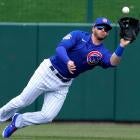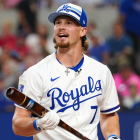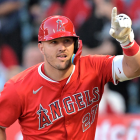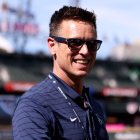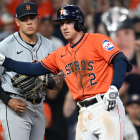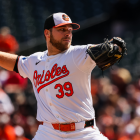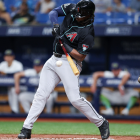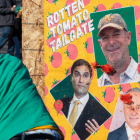MESA, Arizona -- A year is a long time. So much can happen to a person in the span of 365 days. The last 12 months have certainly made a difference for Cubs outfielder Ian Happ.
Last year, Happ was en route to an extended stint in the minors, despite appearing in 142 MLB games the previous season and posting a strong rookie campaign in 2017. This time around, he feels primed to win the majority of the Cubs' time share in center field.
Happ was a surprise demotion last season. It was assumed by most he'd land at least a bench role. He hit .233/.353/.408 (102 OPS+) in 2018 with the defensive versatility to play all over the diamond -- he played every position but catcher and shortstop that season -- and certainly looked the part of a major-league player.
Of course, there were issues. In 2018, he struck out 36.1 percent of the time. His batting average dropped 20 points from his rookie year. Perhaps most worrisome: He went from 24 homers in 413 plate appearances as a rookie to 15 homers in 462 trips to the dish as a sophomore. His slugging percentage dropped from .514 to .408. Simply, he was striking out like a big-time slugger while slugging like a middleweight.
Per new manager David Ross, there was nothing wrong with the organization admitting Happ needed the stint in Triple-A.
"There are a lot of guys over the course of the history of baseball that were sent down and came back to be potentially Hall of Famers," Ross said Thursday at Cubs camp. "I don't think that being sent down is some kind of huge negative impact. Everybody develops in different ways and gets to the big leagues and the weaknesses get exposed. Things come up that you need to work on. It's hard. It's a big jump from the minor leagues to the major leagues and sometimes you gotta go back down and figure out how to work on some things without all the pressure of a major-league season and a crowd of 50,000 people."
A few months into Happ's stint with Iowa, something seemed to click. In his last 18 games there, he hit .348/.469/.667 with four doubles, a triple and five home runs in 81 plate appearances.
He earned the promotion back to the bigs.
The new Happ cut back his strikeout rate to 25 percent and his power stroke reappeared. In 156 plate appearances, he hit 11 homers and slugged .564. He more than doubled his WAR from 2018 in a sliver of the time: 1.2 WAR in 58 games in 2019 compared to 0.5 in 142 games in 2018.
When I asked Happ how he felt about things this spring, he was direct. "I feel great, having a good camp," he said.
Ross described Happ as a "man on a mission" this spring. Though Ross warned that spring training stats can be misleading and there are more important things, like underlying factors.
Happ is checking both boxes. Heading into Thursday's afternoon tilt, Happ is slashing .467/.471/.933(!) with a double, two homers and eight RBI in 17 spring plate appearances. It's a small sample in games that don't actually matter, but still, he's been on fire and that's encouraging for the player and the organization.
Ross also pointed out that Happ is putting in the work to become the best all-around player he can be. His first step in center field is improved. He's beginning to truly look the part of an everyday center fielder.
That is something the Cubs have lacked since Dexter Fowler departed via free agency following the 2016 World Series championship. The top internal candidate to replace Fowler for a few years was Albert Almora -- and, to be clear, Ross sang Almora's praises and Almora is hitting very well this spring -- but he hasn't really gained traction as an everyday option. With Happ being a switch hitter and flashing the power upside as well on the on-base chops (Almora rarely walks and doesn't hit for near as much power), he's appears to be the better fit of the two.
Time will tell, of course. It's March 5. But it feels like Happ is well on his way to nailing down the center field job heading into the 2020 season. What a difference a year makes, right?









